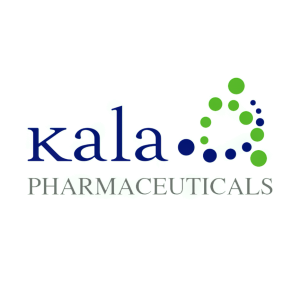KALA BIO Reports Second Quarter 2025 Financial Results and Provides Corporate Update
Rhea-AI Summary
KALA BIO (NASDAQ:KALA) reported Q2 2025 financial results and provided updates on its clinical programs. The company completed enrollment for its Phase 2b CHASE trial of KPI-012 for Persistent Corneal Epithelial Defect (PCED), with topline data expected by end of September 2025. The trial enrolled 79 patients across 37 sites in the US and Latin America.
The company's cash position stands at $31.9 million as of June 30, 2025, expected to fund operations into Q1 2026. Q2 2025 resulted in a net loss of $11.2 million ($1.71 per share), compared to $9.6 million ($3.16 per share) in Q2 2024. The CHASE trial could potentially serve as a pivotal trial for BLA submission, subject to positive results and regulatory discussions.
Positive
- None.
Negative
- Increased net loss to $11.2M in Q2 2025 from $9.6M in Q2 2024
- Higher R&D expenses at $6.2M compared to $5.3M year-over-year
- Increased G&A expenses to $4.6M from $4.3M year-over-year
- Cash decreased from $42.2M to $31.9M during Q2 2025
News Market Reaction 1 Alert
On the day this news was published, KALA gained 3.07%, reflecting a moderate positive market reaction. This price movement added approximately $1M to the company's valuation, bringing the market cap to $50M at that time.
Data tracked by StockTitan Argus on the day of publication.
-- Completed patient enrollment in Phase 2b CHASE trial of KPI-012 in Persistent Corneal Epithelial Defect (PCED); topline data expected at the end of September 2025 --
-- Cash resources of
ARLINGTON, Mass., Aug. 08, 2025 (GLOBE NEWSWIRE) -- KALA BIO, Inc. (NASDAQ:KALA), a clinical-stage biopharmaceutical company dedicated to the research, development and commercialization of innovative therapies for rare and severe diseases of the eye, today reported financial results for the second quarter ended June 30, 2025 and provided a corporate update.
“The second quarter of 2025 was a pivotal period for KALA, marked by the completion of patient enrollment in our Phase 2b CHASE trial of KPI-012 in PCED and the continued execution of our clinical and corporate strategy,” said Todd Bazemore, interim Chief Executive Officer of KALA BIO. “We are well-positioned heading into our key readout of the CHASE trial, which we believe has the potential to serve as a pivotal trial required to support a Biologics License Application (BLA) to the U.S. Food and Drug Administration (FDA), contingent on positive results and subject to discussions with regulatory authorities. We are now focused on finalizing study activities and remain on track to report topline results at the end of September of this year.”
Mr. Bazemore continued, “In July, we hosted a virtual KOL event featuring leading cornea specialists who underscored the high unmet need for patients with PCED and highlighted the potential of KPI-012’s multifactorial mechanism of action to address all underlying etiologies of this debilitating and clinically burdensome condition. With no FDA-approved products covering all underlying etiologies of PCED, we believe KPI-012 has the potential to dramatically improve the treatment paradigm for the estimated 100,000 patients with PCED in the United States.”
Second Quarter and Recent Business Highlights:
KALA’s innovative pipeline is based on its proprietary mesenchymal stem cell secretome (MSC-S) platform. KALA believes the multifactorial mechanism of action of its MSC-S platform technology may enable it to generate product candidates for a range of rare, ocular diseases and is evaluating the potential development of this technology for multiple rare, front- and back-of-the-eye diseases.
KALA’s lead product candidate, KPI-012, contains numerous growth factors, protease inhibitors, matrix proteins and neurotrophic factors that can potentially correct the impaired corneal healing that is an underlying etiology of multiple severe ocular diseases.
KALA is initially developing KPI-012 for the treatment of Persistent Corneal Epithelial Defect (PCED), a persistent, non-healing corneal defect or wound that is refractory to conventional treatments which, if left untreated, can lead to significant complications, including infection, corneal perforation/scarring and vision loss. PCED has an estimated incidence of approximately 100,000 patients in the U.S., representing a potentially sizeable market opportunity as there are currently no U.S. Food and Drug Administration (FDA)-approved prescription products with a broad indication covering all underlying etiologies of PCED. KPI-012 has received both Orphan Drug and Fast Track designations from the FDA for the treatment of PCED.
- In July 2025, KALA announced the completion of patient enrollment in the CHASE (Corneal Healing After SEcretome therapy) Phase 2b clinical trial evaluating KPI-012 for the treatment of PCED. The trial randomized 79 patients across 37 sites in the United States and Latin America with verified PCEDs at baseline that will be eligible for inclusion in the primary efficacy analysis. The Company expects to report topline data from the trial at the end of September of 2025. Contingent on positive results and subject to discussion with regulatory authorities, KALA believes the CHASE Phase 2b trial could potentially serve as a pivotal trial to support the submission of a Biologics License Application (BLA) to the FDA.
- In July 2025, KALA hosted a webcast event with Key Opinion Leaders (KOLs) to discuss the potential of KPI-012 for the treatment of PCED. The KOLs provided a disease overview of PCED, including the unmet need and patient journey, as well as insights into KALA’s MSC-S technology, KPI-012's multi-factorial mechanism and the CHASE clinical trial design. Company management reviewed the commercial opportunity of KPI-012 and provided an update on upcoming milestones. An archived replay of the event is available under “Presentations” in the Investor section of the Company’s website at www.kalarx.com.
- KALA is also exploring the potential of KPI-012 for additional rare, front-of-the-eye diseases, including Limbal Stem Cell Deficiency (LSCD). LSCD is characterized by the loss or deficiency of limbal epithelial stem cells, which can result in recurrent epithelial breakdown, conjunctivalization, inflammation, neovascularization and other sequalae that can lead to significant symptomology and a loss of corneal clarity and vision impairment. Like PCED, LSCD represents a potentially substantial market opportunity, with an estimated incidence of 100,000 patients in the U.S.
KPI-014, KALA’s preclinical program to evaluate the utility of its MSC-S platform for inherited retinal degenerative diseases, contains neurotrophic factors, growth factors, anti-inflammatory or immune-modulatory factors and antioxidant inhibitors with the potential to protect and preserve retinal cell function. Secretomes have demonstrated a neuroprotective effect in both in vitro and in vivo models of retinal degeneration. KALA believes KPI-014 could offer a gene-agnostic approach for the treatment of rare inherited retinal diseases, such as Retinitis Pigmentosa and Stargardt Disease.
Financial Results:
Cash Position: As of June 30, 2025, KALA had cash and cash equivalents of
Three Months Ended June 30, 2025 Financial Results:
- G&A Expenses: For the quarter ended June 30, 2025, general and administrative (G&A) expenses were
$4.6 million , compared to$4.3 million for the same period in 2024. The increase was primarily due to an increase in stock-based compensation expense. - R&D Expenses: For the quarter ended June 30, 2025, research and development (R&D) expenses were
$6.2 million , compared to$5.3 million for the same period in 2024. The increase was primarily related to an increase in employee-related costs and KPI-012 development costs. - Loss (gain) on Fair Value Remeasurement of Contingent Consideration: For the quarter ended June 30, 2025, the loss on fair value remeasurement of contingent consideration, in connection with the Combangio acquisition, was
$0.2 million , compared to a gain of less than$0.1 million for the same period in 2024. - Operating Loss: For the quarter ended June 30, 2025, loss from operations was
$11.0 million , compared to$9.6 million for the same period in 2024. - Net Loss: For the quarter ended June 30, 2025, net loss was
$11.2 million , or$1.71 per share, compared to a net loss of$9.6 million , or$3.16 per share, for the same period in 2024. The weighted average number of shares used to calculate net loss per share was 6.5 million for the quarter ended June 30, 2025, and 3.0 million for the quarter ended June 30, 2024.
Six Months Ended June 30, 2025 Financial Results:
- G&A Expenses: For the six months ended June 30, 2025, G&A expenses were
$9.2 million , compared to$9.7 million for the same period in 2024. The decrease was primarily due to a decrease in employee-related costs. - R&D Expenses: For the six months ended June 30, 2025, R&D expenses were
$12.3 million , compared to$11.7 million for the same period in 2024. The increase was primarily related to an increase in employee-related costs and KPI-012 development costs. - Loss on Fair Value Remeasurement of Contingent Consideration: For the six months ended June 30, 2025, the loss on fair value remeasurement of contingent consideration, in connection with the Combangio acquisition, was
$0.2 million , compared to$0.1 million for the same period in 2024. - Operating Loss: For the six months ended June 30, 2025, loss from operations was
$21.7 million , compared to$21.5 million for the same period in 2024. - Net Loss: For the six months ended June 30, 2025, net loss was
$20.1 million , or$3.13 per share, compared to a net loss of$21.4 million , or$7.32 per share, for the same period in 2024. The weighted average number of shares used to calculate net loss per share was 6.4 million for the six months ended June 30, 2025, and 2.9 million for the six months ended June 30, 2024.
About KALA BIO, Inc.
KALA is a clinical-stage biopharmaceutical company dedicated to the research, development and commercialization of innovative therapies for rare and severe diseases of the eye. KALA’s biologics-based investigational therapies utilize KALA’s proprietary mesenchymal stem cell secretome (MSC-S) platform. KALA’s lead product candidate, KPI-012, is a human MSC-S, which contains numerous human-derived biofactors, such as growth factors, protease inhibitors, matrix proteins and neurotrophic factors that can potentially correct the impaired corneal healing that is an underlying etiology of multiple severe ocular diseases. KPI-012 is currently in clinical development for the treatment of persistent corneal epithelial defect (PCED), a rare disease of impaired corneal healing, for which it has received Orphan Drug and Fast Track designations from the U.S. Food and Drug Administration. KALA is also exploring the potential development of KPI-012 for the treatment of Limbal Stem Cell Deficiency and other rare corneal diseases that threaten vision and has initiated preclinical studies to evaluate the potential utility of its MSC-S platform for retinal degenerative diseases, such as Retinitis Pigmentosa and Stargardt Disease. For more information on KALA, please visit www.kalarx.com.
Forward Looking Statements:
This press release contains forward-looking statements within the meaning of the Private Securities Litigation Reform Act of 1995 that involve substantial risks and uncertainties. Any statements in this press release about KALA’s future expectations, plans and prospects, including but not limited to statements about KALA’s expectations with respect to potential advantages of KPI-012 and its MSC-S platform; the clinical utility of KPI-012 for PCED; anticipated timelines to report topline data for the CHASE Phase 2b clinical trial of KPI-012; KALA’s belief that the CHASE Phase 2b trial could serve as a pivotal trial to support the submission of a BLA to the FDA; KALA’s plans to pursue research and development of KPI-012, KPI-014, and its MSC-S platform for other indications; the sufficiency of KALA’s existing cash resources for the period anticipated; and other statements containing the words “anticipate,” “believe,” “continue,” “could,” “estimate,” “expect,” “intend,” “likely,” “may,” “plan,” “potential,” “predict,” “project,” “should,” “target,” “will,” “would,” and similar expressions constitute forward-looking statements. Actual results may differ materially from those indicated by such forward-looking statements as a result of various important factors, including: uncertainties inherent in the initiation and conduct of preclinical studies and clinical trials; uncertainties regarding availability and timing of data from clinical trials; whether results of early clinical trials or trials in different disease indications will be indicative of the results of ongoing or future trials; whether results of the Phase 1b clinical trial of KPI-012 will be indicative of results for any future clinical trials and studies of KPI-012, including the CHASE Phase 2b clinical trial; whether interim data from a clinical trial will be predictive of the results of the trial; uncertainties associated with regulatory review of clinical trials and applications for marketing approvals; KALA’s ability to retain and hire key personnel; KALA’s ability to comply with the covenants under its loan agreement, including the requirement that its common stock continue to be listed on The Nasdaq Stock Market; the sufficiency of cash resources and need for additional financing and other important factors, any of which could cause KALA’s actual results to differ from those contained in the forward-looking statements, discussed in the “Risk Factors” section of KALA’s Annual Report on Form 10-K, most recent Quarterly Report on Form 10-Q and other filings KALA makes with the Securities and Exchange Commission. These forward-looking statements represent KALA’s views as of the date of this press release and should not be relied upon as representing KALA’s views as of any date subsequent to the date hereof. KALA does not assume any obligation to update any forward-looking statements, whether as a result of new information, future events or otherwise, except as required by law.
Financial Tables:
| KALA BIO, Inc. Balance Sheet Data (in thousands) (unaudited) | ||||||
| June 30, 2025 | December 31, 2024 | |||||
| Cash and cash equivalents | $ | 31,942 | $ | 51,181 | ||
| Total assets | 36,053 | 55,483 | ||||
| Working capital(1) | 17,647 | 35,841 | ||||
| Current portion of long-term debt | 9,511 | 10,336 | ||||
| Long-term debt, net of discounts | 18,786 | 20,102 | ||||
| Other long-term liabilities | 4,457 | 6,093 | ||||
| Total stockholders’ (deficit) equity | (3,206 | ) | 12,332 | |||
(1) The Company defines working capital as current assets less current liabilities. See the Company’s consolidated financial statements for further information regarding its current assets and current liabilities.
| KALA BIO, Inc. Consolidated Statement of Operations (In thousands, except share and per share data) (Unaudited) | ||||||||||||||||
| Three Months Ended June 30, | Six Months Ended June 30, | |||||||||||||||
| 2025 | 2024 | 2025 | 2024 | |||||||||||||
| Costs and expenses: | ||||||||||||||||
| General and administrative | $ | 4,643 | $ | 4,317 | $ | 9,236 | $ | 9,739 | ||||||||
| Research and development | 6,232 | 5,317 | 12,287 | 11,668 | ||||||||||||
| Loss (gain) on fair value remeasurement of contingent consideration | 153 | (29 | ) | 174 | 129 | |||||||||||
| Total operating expenses | 11,028 | 9,605 | 21,697 | 21,536 | ||||||||||||
| Loss from operations | (11,028 | ) | (9,605 | ) | (21,697 | ) | (21,536 | ) | ||||||||
| Other income (expense): | ||||||||||||||||
| Interest income | 407 | 504 | 870 | 1,008 | ||||||||||||
| Interest expense | (1,081 | ) | (1,458 | ) | (2,172 | ) | (2,913 | ) | ||||||||
| Grant income | 547 | 980 | 2,897 | 2,055 | ||||||||||||
| Total other income (expense) | (127 | ) | 26 | 1,595 | 150 | |||||||||||
| Net loss | $ | (11,155 | ) | $ | (9,579 | ) | $ | (20,102 | ) | $ | (21,386 | ) | ||||
| Net loss per share attributable to common stockholders—basic and diluted | $ | (1.71 | ) | $ | (3.16 | ) | $ | (3.13 | ) | $ | (7.32 | ) | ||||
| Weighted average shares outstanding—basic and diluted | 6,513,108 | 3,030,213 | 6,429,950 | 2,921,712 | ||||||||||||
Investor Contact:
Taylor Steiner
taylor.steiner@precisionaq.com
212-362-1200








